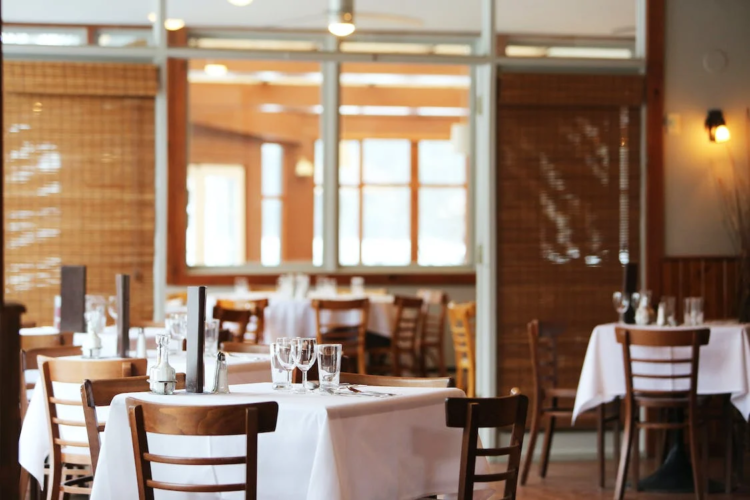By Steve Price
Restaurant etiquette is a series of refined skills that have slowly been lost in a culture that is obsessed with me, myself and I. Too often, people head out for a night on the town and lose themselves in the moment, irrespective of those around them or the improprieties that they may be committing. It may seem old hat, but there is nothing more fashionable than exercising some restraint when choosing to dine out for a fine meal. Of course, good restaurant etiquette extends beyond not arriving at a restaurant half an hour before the kitchen closes (which you should never do, by the way). It seeps into the full experience, before, during and after the meal itself.
Well-Sewn is proud to champion the reestablishment of civility and respect in the dining game with a series of tips and pointers on how to become a more refined diner, helping you elevate your game from slovenly guest to well-suited connoisseur.
Before You Arrive at the Restaurant
Before setting out for the evening, make sure to dress for the occasion! Never wear a t-shirt and shorts to a fine dining restaurant; some would suggest never wearing t-shirts out in public to begin with, but be that as it may. Consider the location that you have chosen for your meal out and scale your wardrobe appropriately to match the aesthetic of the restaurant. A pair of slacks and a polo shirt would be fine for a low-end steakhouse, while business casual or better might be more apropos for dining at more exclusive establishments.
When choosing a restaurant to patron for a meal out, do not expect the restaurant to ‘tailor’ itself to your dining proclivities. In other words, if you enjoy a pescatarian diet at home, consider choosing a seafood restaurant or other dining establishment that has seafood on the menu, rather than going to, say, a barbecue smokehouse. Vegans should think twice before choosing a steakhouse as their restaurant of choice, knowing ahead of time that the menu’s offerings may leave them with slim choices for the dining experience. Those with food allergies should consider contacting a restaurant ahead of time for information before waiting to find out when seated with menus in hand.
Most notably, consider the experience of your fellow restaurant patrons when choosing who to bring with you to a meal. If you intend to spend the evening at a restaurant themed for children or families, bringing your younger children may be appropriate; however, young children, particularly infants and toddlers who are unable to control their emotions yet may be less appropriate at a fine dining restaurant where patrons are paying as much for the experience as they are the food. Consider this when choosing a restaurant for the evening out with the little ones, or consider hiring a sitter in order to share a more intimate evening out.
During Your Dining Experience
When you arrive to the restaurant, remember to never wear a hat or headwear at the table, and always place tablecloth napkins in your lap for the duration of your meal. Follow social cues for those around you who are dining with you to determine whether conversation is appropriate at any given moment; that moment is almost universally excluding when you have food in hand or on the cutlery. Respect the privacy and wishes of those around you when dining at a fine restaurant and keep your conversational tone low enough to not be heard at tables next to you.
When possible, refrain from sending food back for small mistakes or errors, as doing so represents bad form and needlessly complicates the life of the servers who are working hard to make your meal an enjoyable experience from start to finish. There is a stout difference between asking for a rare steak and getting mid-rare from getting a rare steak when desiring a well-done steak, after all. If you must send something back, either because it is improperly prepared or due to a cleanliness issue, do so without drawing any more attention to the problem than necessary.
Most importantly, always treat your servers with kindness, because they are working an impossibly difficult job in an era when staff shortages are becoming more and more common place. Always be respectful to servers when placing an order, and wait at least 15 to 30 minutes before inquiring about the state of your food in the kitchen if it has yet to arrive at the table. Doing so will not only help prevent unnecessary commotion at the tableside, but it will also endear you to your servers and ensure that you will receive the best possible service possible for the duration of your dining experience at the restaurant.
After the Meal is Finished
Once your meal is finished, be sure to tip appropriately for the culture in which you are surrounded. Unless gratuity is automatically added to your bill, or you are in countries where tipping is considered impolite, it is always best to consider leaving a tip as a way of thanking the server for their hard work. Most individuals follow the 15-18% gratuity rule, leaving that percentage of the total check behind as a tip for the server, but do not hesitate to tip more freely for those servers who go above and beyond the call for you during your dining experience.
Never punish the server for food preparation mistakes that fall on the kitchen staff; servers are often caught in the middle between overworked kitchen staffers and angry customers dealing with incorrect orders. If something was incorrectly prepared or not to your liking, remember not to take any lingering frustration out on the server who set out to try and make your meal an enjoyable experience. Separate the mistakes of the kitchen from the server staff when considering leaving behind gratuity or comments about the service to the general manager of a restaurant.
One issue that must be brought up here is marking the difference between food being prepared incorrectly according to your order and not liking something that you were brought. Often times, people will receive the correct order, only to not enjoy what they had chosen and then try to have their meal discounted or removed from the final check; this is poor practice and should be avoided at all cost. Only consider asking for something to be removed from a final bill of sale if the order was incorrectly prepared to such an extent that it could not be eaten or enjoyed; if necessary, politely ask the server to speak with the manager and calmly explain what was wrong with the meal. They will usually work to accommodate you without further issue.
Following these simple guidelines will not only up your restaurant game, but it will vastly improve your social skills and your crowd aesthetic in a major way. Having the etiquette of a refined gentlemen or lady at the dining table brings with it an air of civility that is sorely lacking in today’s society. It reflects well on you, and those around you, and should embody every conscious action taken while enjoying a night out on the town.




One Reply to “Restaurant Etiquette 101: Take Dining to the Next Level”
נערות ליווי בבאר שבע
I was very pleased to find this site. I wanted to thank you for your time for this particularly wonderful read!! I definitely savored every little bit of it and i also have you book-marked to see new stuff in your site.